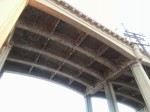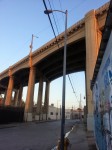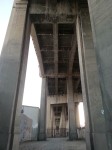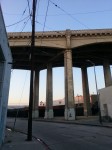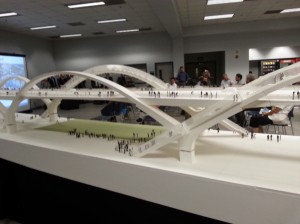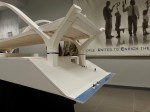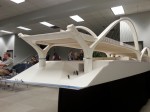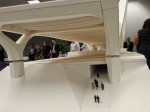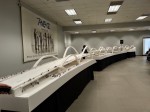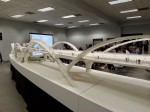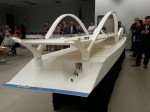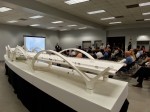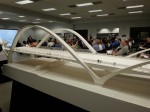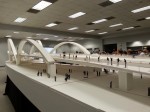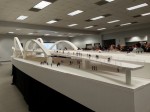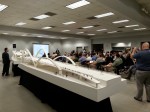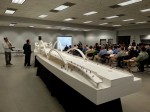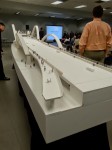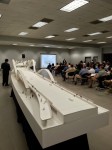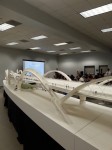A community organizer’s account of the debut for the new Sixth Street Bridge Project – October 6th, 2014
 Before I went to the city planning meeting that day, I just had to take one more wide look of this Sixth Street Viaduct. Watching her from the distance of the Seventh Street Bridge, I somberly took in full view of the crumbling Sixth Street Bridge there in the middle of it all. I needed to see the activity and the interconnectivity she provides for this community, just to keep the subject in perspective.
Before I went to the city planning meeting that day, I just had to take one more wide look of this Sixth Street Viaduct. Watching her from the distance of the Seventh Street Bridge, I somberly took in full view of the crumbling Sixth Street Bridge there in the middle of it all. I needed to see the activity and the interconnectivity she provides for this community, just to keep the subject in perspective.
The viaducts of the Los Angeles river are an integral part the city, more than many people realize at first. These structures here were created not just to traverse the river, but also to serve as essential corridors for our local freeways. And also for providing passage for all our local commercial and passenger trains; the Amtrak and Metrolink trains, being among them.
My personal favorite of them is the Sixth Street Viaduct. Almost everyone in the city commutes over, under and through this structure on a regular basis. And so it has been for as long as any of us remember, that we find our goings and comings from the city greeted by the glory of this bridge and her arches.
And this bridge has also become the primary hang-out for my friends and I over the years. A part of our city infrastructure we feel most connected to. Most often taking our spot at the observation point on the north end of the pedestrian walkway. From here we have always watched and reflected upon this great city. It is almost hard for us to imagine the city landscape without her.
The historic Sixth Street Viaduct which has graced the city skyline since 1932 has been scheduled for demotion and replacement. As for many years there have been concerns about the structural integrity of the bridge.
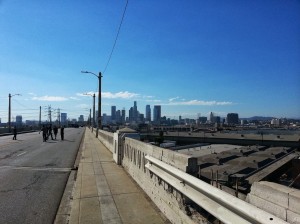 Indeed, history tells us that within the first 20 years of the bridge being built the concrete of the structure began to suffer terrible damage. The consequences of badly mixed concrete in the construction, utilizing a poor choice of sand aggregate in the mixture. The grains of sand and the concrete-mix having a fatal reaction when repeatedly exposed to water over time, causing the mixture to produce a corrosive gel, as the sand grains swell with moisture. The concrete eventually becoming brittle enough to crack, separate and fall away. A condition called alkali-silica reaction, or “concrete cancer” by the engineers.
Indeed, history tells us that within the first 20 years of the bridge being built the concrete of the structure began to suffer terrible damage. The consequences of badly mixed concrete in the construction, utilizing a poor choice of sand aggregate in the mixture. The grains of sand and the concrete-mix having a fatal reaction when repeatedly exposed to water over time, causing the mixture to produce a corrosive gel, as the sand grains swell with moisture. The concrete eventually becoming brittle enough to crack, separate and fall away. A condition called alkali-silica reaction, or “concrete cancer” by the engineers.
The bridge is literally crumbling and melting away. This is a serious crisis, for certain.
But I’ll tell you the truth: I have never seen anything as broken and damaged as the politics which surrounds the entire rebuilding project for the Sixth Street Viaduct. This has been what I have found most alarming here.
Let us consider the project, and all its implications. We are talking about a reconstruction project which when originally proposed it was estimated to cost at around $140-million dollars, which has since morphed and ballooned into over $440-million; a project which is consuming 2/3rds of the entire infrastructure development budget of the City of Los Angeles. And yet for all the money committed, this bridge project remains the most egregious symbol of inequity in the current city redevelopment.
Here we are at the start of another building project here which is wrong from the beginning. With the current failures of this project reflecting the deafness of both the civic and neighborhood council leaders. This all clearly demonstrating the complete failure on the part of our local leaders across the board to advocate for the needs our disadvantaged community which is most effected by this project; the neighborhood of Boyle Heights.
So here I gathered my thoughts here for a few moments. And then finally walked my way from the viaduct and over to the local magnet school which was hosting the community forum for the Sixth Street Viaduct Replacement Project. A much-anticipated update from the city and the contractors, regarding the demolition and rebuilding.
And as I walk up to the entrance I run into the Los Angeles City Council member for this district, Jose Huizar. We pass with barely a pleasantry, greeting and parting abruptly.
Actually I think the same can be said for his appearance at this meeting in general. His very presence at the community forum was short and abrupt. Excusing himself for another hearing after a few short words, and conveniently not having to be present to answer for any of the community concerns regarding the project.
As the community members began to pile in to a room mostly filled with suits and contractors, we also joined them; my local companions and I. This was not our first time at the rodeo, but even we were shocked by the fruitlessness of this forum.
Huizar came with his usual attempt at charm and carefully expressed sympathy over the loss of this iconic bridge, though in the end all he did was do political nodding and offered little of substance. He had a few nice things to say which I appreciated, about developing the art of the space and reusing materials from the historic bridge. The latter of which I believe is the most sincere.
What I found troubling was one of his last and briefest points to address, regarding the redevelopment of the underside of the bridge. In which he credits his office with securing $1-million for the construction of a “soccer park” on the cleared land underneath the bridge.
As he mentioned this my eyes were drawn to the diagrams and maps, to take notice how the businesses in the Boyle Heights Flats are effected. Only to notice many cleared away in the new renderings. I know the area very well. And every single business which they are replacing with just grass there in their diagrams.
In reality, they are not adding much more than white lines and adding two words to the remaining open field, and it thus becomes a “soccer park.”
Now how is that a community organizer like myself, in a Latino community, is opposed to this? My opposition is to a clearly mindless form of ethnic pandering here. And my scorn is for the cheap and token redevelopment feature aimed to pacify Latino objection to a highly unpopular redevelopment project. A typical move which is not just cynical, but also inequitable.
What completely amazed me was that just a year before at similar public briefing and forum hosted by Huizar’s office the city had warmed us all over with emphasizing that the bridge was to be transformed into a destination on both banks, with active artistic and cultural components. Stating that this all needed to be equitable and integral to the space, so as not to feel like an afterthought.
[Citation: See video of the December 11, 2013 meeting; citing Felicia Filer, Department of Cultural Affair. My favorite part is this, “There are so many different areas on the project in which public art happen. Where art can happen and future art programming. We wanted to look at the project holistically and cohesively, so that wherever opportunities are they tie together, so that it feels like a plan and not an afterthought.” Felicia Filer, Department of Cultural Affairs. I would say we are all in agreement with her, which is why it is shocking they have in the end planned nothing significant in terms of integrated programmable artistic and cultural space on the eastern side of the bridge.].
However, now what we had being presented to us was far less than carefully balanced. A revelation that would further be compounded as the city planners and engineers unveiled the model and animations for the new Sixth Street Viaduct. Complete with an amphitheater and an “arts park” to be constructed on the now gentrified Art District side of the bridge, on the western bank of the Los Angeles River.
While as for their plans for under the much larger Boyle Heights span, so far all they had to show for was an afterthought of a soccer field feature being represented by a piece of green construction paper under their model of the eastern span of the bridge; in the struggling minority community on the other end.
Very much an afterthought and point of disregard, as revealed by the words of Huizar himself: “We recently also awarded, through some of the advocacy of my office, a million dollars for a soccer field on the bottom of the Art’s District side, right?” To the solicited correction of his staff, he snapped back, “… Boyle Heights side. Right. Boyle Heights side.”
—
The viaduct of today is just about 2/3 of a mile long; 3500′ of bridge, with 400′ of twin double steel arches spanning over the river where the bridge slightly curves southwest as it extends towards downtown LA. The painted bluish-gray arches standing 40′ high, are the most beloved accent of the bridge.
The old bridge was designed at the height of the Art Deco era. The design shows both Art Deco and streamline Moderne themes, the first bridge of it’s kind. Indeed each of the bridges have a unique theme to them. Some of them neo-Classical like the First Street Bridge, and others are Gothic Revival like the nearby Fourth Street Bridge. All of them made to play off of and accentuate each other.
This motif has great historical significance to us locals, in providing functional and yet comfortingly classic atmosphere to our area. For these reasons, the Sixth Street Viaduct is designated as Historic-Cultural Monument #905 by the California Register of Historical Resources.
The bridge of the future is tremendously different. As the civil engineers spoke, we all stared eagerly at the scale model which took up the whole auditorium. This new design being a great departure from the current architectural theme of the area, and also from the previous design plans. Almost nothing of the original bridge and charms were retained, except for an embellished stream of integrated arches designed to span nearly the full length of the bridge.
 There is no doubt that the new bridge design is bold and breathtaking. However, it is more stupefying when we see that they have diminished the historical integrity of the surrounding area in ways which appears to push a wave of sweeping redevelopment and character changes upon this area.
There is no doubt that the new bridge design is bold and breathtaking. However, it is more stupefying when we see that they have diminished the historical integrity of the surrounding area in ways which appears to push a wave of sweeping redevelopment and character changes upon this area.
Considering all the other options for the rebuild, this most certainly is the best design. Early on in the design planning for the new viaduct, reproductions of the bridge were considered. Reproductions of the old bridge without any arches, a lackluster redesign which would have done no justice to the original Sixth Street Bridge. This bridge design as least incorporates an homage to the original arches. Which is quite meritorious.
And the bridge also does comes with some impressive features. The new Sixth Street Viaduct is designed to have protected bike lanes and paths. As well as a safer pedestrian walkways, secured by dividers. And circling bicycle ramps which promise easy acceptability.
As the presentation continues, we hear of how the “Ribbon of Light” theme for the bridge will incorporate embedded LED lighting. State of the art lights which can be changed in color in order to enhance the bridge, thematically or according to artistic tone. Mood light streaming along the face of the bridge and walkways. An admittedly expensive, but beautifying feature integrated into the bridge.
Most impressive though are the integrated artistic and cultural space planned for much smaller, western span of the bridge; on the Arts District Side. The amphitheater which will meet up against the entrance to the service tunnel of the Los Angeles River. Re-envisioning the almost urban cathedral nature of the underside of the bridge there as a programmable space. With an arts park which also planned for the adjacent areas.
These type of features are not by accident. Indeed early on in the process of the redesign the now gentrified Los Angeles Art’s District had demanded a percentage – I believe at one point they wanted as much as 4% of the redevelopment money – in order to apply to artistic redevelopment of their area. In the end, some effective advocacy for their community resulted in the incorporation of these grand features, the amphitheater and arts park.
What I find starkly contrasting is that for all of this light and programmable space being planned here, the only thing that this massive model has presented for the Boyle Heights side of bridge – for the 2500-feet which makes up over 2/3rds of the length of the bridge – is a piece of green construction paper on the underside of the bridge just west of Anderson St. An ad-hoc representation of their trite afterthought of a soccer field. This green piece of paper being just as barren and honest as the reality of that plan, just an empty green space left on the dark underside of their bridge.
For the first time I really felt the full effect of the dissonance which the community members around me also felt in the face all this. Even I began to feel the tension.
The civic planners have made great use of space in their designs for artistic expression in the gentrified side of town. And it makes great concessions to the newly arriving yuppies who need to feel that their own contrived being is in itself artisanal, who see their very privileged lives as performance art.
But what about for the genuinely culture rich Boyle Heights? What for the side which has a well established historical tradition of folk and applied arts? The east side – which has great historical significance for it’s rich ethnic and cultural character – what did we get for tangible programmable arts space? Gornisht mit gornisht… un montón de nada… a lot of nothing.
—
One of the hard things about going to public meetings in the eastside is that they are also so tense and heated. And quite frankly, they are uncivil much of the time. We are an engaging community, but not overly sophisticated. We just want straight answers and not all the politically correct talk.
Though quite frankly, our meetings are generally filled with more than a few agitators.
Personally, I don’t desire the role of an agitator. Now my younger friends are fantastic agitators, who love to protest and cause a stir! In fact it was hard for me to get them to agree to go into the actual meeting originally, as their first instinct is generally to protest and claim victory if they get enough weird looks. Which has always frustrated me about many of them.
Personally, I find it more useful and infinitely more devastating to just ask questions of the civic planning people. To make them answer specifics for us.
We are all well aware that there is a lot of money being spent here. We all understand that the integrated design upgrades are what increased the cost of this project, thereby padding the project in order to draw in big federal money into area to meet their ambitious plan. And it’s hard for the civic planners not to love their own big pork-barrel project being rolled out here, in an area of town which sincerely needs infrastructure upgrades. But the increase in cost from the original figure is just over the top.
So I turn to some of the professionals next to me who are talking about the cost of this project. I ask how is it possible, even after taking into account the resign upgrades, that the project could be this expensive? How do you jump the cost by $300-million like that?
One guy in a suit turns to me and says: “Oh, that must be the cost adjustment relating to prevailing wages.” Stating that increase in cost is mostly likely related to increases in labor costs.
This comes with nods in agreement from the other men sitting around me, most of them contractors. Indeed most of the people around me are building project people and hopeful sub-contractors, but only a few community people.
My friends are pissed off by just about everything that they have heard so far. But they are sitting in this meeting patiently and attentively for now. I had asked them to stick around a while longer because we are going to be hearing about the jobs that this project is supposed to be attracting.
If anything we should be there to find out how working-class people in our community could benefit from this project. To find out how to put our people to work on this massive demolition and construction project. I figured I would ask about the types and number of jobs offered. Hoping to maximize job options for our local workers. Our people need jobs!
But the questions would be quickly answered for me. The project would attract about 250 workers at any given time, with contract workers expecting to be on site no more than about a week of the four-year building project. Certainly that is not anything which is going to be life changing for any of the workers and families in our area. The employment gains for our people in this project are dismal, despite the size and scale of this project.
As the presentation goes on it is made clearer that real audience at this point is made up mostly of potential sub-contractors filling the room. All chomping at the bit to get their part of this contract money. All trying to sweeten up the suits, passing cards back and forth.
To the other side of me are the actual members of the community, from the Arts District and the Boyle Heights Flats. Who all the while are amongst themselves complaining about how they are left out of the loop regarding project developments. People venting their dismal assessment of a project that not just fails to duly inform them, but also is progressively lagging further behind in schedule. With the start of the project being already a year-and-a-half behind schedule to begin with. People here venting their fears to each other that this project is likely to lag even longer than expected, unduly impacting their area.
People wanted to know, how do they promise that a bridge will be done in time on 2019 when they are already a year-and-a-half behind schedule to begin with?
So what catches our attention are the next words by the project consultant Joe Hernandez (J Hernandez Consulting), which were clearly meant for the contract chasers filling the room. Shocking words to laborers and stunning to the local public: “There won’t be any concern for uh, uh, strike… or anything which might delay the project as far as the labor force is concerned, because the agreement is that there is a ‘no strike clause.’” Referring to the Project Labor Agreement (PLA) they now begin boasting.
The gentleman continues. “And maybe one of the important elements to you there is that there is a disadvantaged component, this is an element which allows us to bring on community members to work on this project.”
My companions had sit put to this point, and like the other community members they were more than willing to introject through the spectator sport of this meeting. And more than willing to vent their frustrations. Murmuring, “So we can work for them, just not with real labor rights?”
The murmuring tone from locals also noticeably grew as Veronica Diaz, the tradeswork liaison (job coordinator) for the project, took to the podium to introduce herself. Intent on getting her own words into this presentation, she pressed her boss to give her the podium.
At first people weren’t too moved as she started presenting her job information in English. Actually, it turned out that in the end people didn’t necessarily appreciate her Spanish, go figure!
“Estoy muy contenta a estar en este projecto.” the last word which Veronica pronounces with a hard Anglo “J” like a less than native Spanish speaker. At this sound the Mexicans sitting in the room respond with undertone derision she seems to have missed, as she did it a couple times in her presentation. “Porque yo naci and creci en esta communidad. Tengo mucho orgullo asistir miembros de la communidad…” Emphasizing that she grew-up in the area.
In the audience people near me roll their eyes and dismiss her as a “vendida” and “token Latina.” Perceiving her as just giving us a few clunky works in Spanish for show. But for the moment I gave the lady a chance. She was the only one who seems to have any physical connection to the community.
She was the designated contact person for tradeswork, and she also explicitly made herself available to talk to crowd about jobs. So I didn’t write her off right away. Out of all the people, I figured her local roots would make her more accessible.
By this point my companions are more than annoyed, so they get up to leave with the other people who had enough already. My friends leave, promising to protest next time.
I went to bid them farewell, myself sticking around a while longer to hear the community forum and get some more info to document. So I walked them out really quickly, before intending on ducking back in to the meeting.
But as I walked back in I see Veronica standing outside of the meeting room, so I approached her and introduce myself. And quickly the conversation turned awkward.
I say to her at first: “I know that these meetings are hard. Many people dislike this project, and not always for the right reasons. But there are some really big concerns here, and hopefully you can help us answer some of them for the community.”
She looks almost amused as she responds to the sight of a young punk rocker in front of her, shooting a nervous smirk to her colleague standing by her side: “Sure.” Though still genial up until this point.
Without hesitation I earnestly and directly inquire of her, “Well, you are telling us that we can come work these jobs. What is really confusing is the mentioned ‘no-strike clause.’ How was this clause secured, and what is it’s impact on fair labor?”
At this point Veronica’s face drops, and she now soberly responds: “We aren’t authorized to talk about that.” She is no longer amused at all.
In amazement I respond: “You and your boss say you are the two people who are designated to speak to the public. You are the job and trade representative, right? You’re here to represent trades-work and tell us we can have jobs with your project, but somehow you aren’t authorized to talk about the labor aspects which impact tradesmen? You want disadvantaged contractors, but first you guys mention that you have taken away their worker’s ability to strike? What does this mean for the laborers?” She says nothing.

Back in October 2014 they were adjusting their projection for the demolition of the old Sixth Street Bridge to take place in Mid-2015. Now the demolition has been further delayed, to early 2016.
I continued: “I mean, this project is already a year-and-a-half behind schedule on your own project’s end. But here you guys are promising everyone that this bridge is going to be finished on time, namely because workers have no ability to strike? You’re putting the impetus of this project being on-time upon labor. How is that? And what is the impact for the unions in such a case of work-site breakdown? You guys seem willing to boast about this ‘no-strike clause’ to the executives present for whom this appeals to. But now you can’t talk to the actual public about the impact of the PLA on laborers? Are you serious?”
She nervously hands me her card, saying she can put me into contact with someone else who might be able to answer my questions. Seemingly shaken and reflexing as though she was offended to have to discuss this.
So now at this point my frustration is palpable as I finally begin to try to relate to her, “You say that you’re from this neighborhood, as you’re straining here to put a local face on this project. You say you know this community? Anyone from this area knows the long and deep history of this community supporting labor and backing strikers. That is part of our heritage here, solidarity during huelga. Our very civil rights movement here was born out of our labor strikes, so it’s something we don’t take lightly! This community has always been the historic core of radical leftism and organized labor. Our great concern for fair labor runs deep for us. You do get that, right? You do at least come knowing people would be turned-off by this ‘no-strike clause’ and that you would have to explain this, right?”
She does little to respond except for nervously nodding her head and trying to move on quickly. Giving the business-class blow-off. I continue in frustration, “Someone with any connection to this community would clearly understand our values and sensibilities here. One would come knowing they have to engage such a topic with workers and labor supporters of our community. For these laborers which you claim you want to hire, to say that they can’t strike without explaining the implication of that, this really isn’t acceptable.”
She didn’t have anything to say, so I finished my tirade, “You need to come here with real answers for the community people in these public hearings. Instead of just going through the motions of a public hearing, while grandstanding to market that you’re bilingual and posturing for the benefit of a room filled with your colleagues. Because this is very typical, but it doesn’t fly.”
All of which left her and the colleague with her reposing, as if overwhelmed and offended. I walked away annoyed, that I now found myself in the role of the agitator.
—
As I make my way back into the meeting, the floor was opened up for some questions from the public.
The first few questions being very representative of the composition of the meeting attendees; the first few questions were from a contractors, downtown real estate agents and architectural enthusiasts.
And then at last, the actual stakeholders from the footprint of the bridge and the surrounding area finally got their opportunity to try to communicate their frustrations.
And it went like this:
“My business is located on [S.] Clarence Street, which is virtually underneath where the new bridge is to go. We have not been contacted by anybody selling the project. It’s just by talking with my neighbors that I found out about it. We would like to know how we are going to be effected. What’s there going to be in terms of outreach towards us? Because we have had zero contact, at all. Okay? We employ 20 people at our location, we employ lots of others people in contracts around the city. Yet we don’t exist as far as this is concerned.”
This was a point made more than once by the public and the journalists present. That the project was actually quite vague in terms of defining the area and identifying what businesses were being cleared in the vicinity of the demolition/building project.
All this lack of clear communication leaving a sense of uncertainty and an inability for the businesses to plan ahead with regard to the impact of this project on their operations.
Though of the concerns raised were regarding to the environmental impact of this project and the effects of detours on their operations. These issues were raised as concerns by a staff member of the local charter school for at-risk youth called Para los Niños. And also by a downtown resident, further noting that the environmental impact report and traffic studies were made long before the recent influx of new Arts District residents.
With the most raised concern surrounding the lack of parking planned in this project. In that this new development promises to turn the Sixth Street Viaduct into a major destination, however they are planning for no additional parking to accommodate these masses of visitor the city planners envision.. A parking concern which the residents contended needed to be addressed in the early planning of the project, and not after the fact.
For anyone who stuck around long enough to listen to the actual community stakeholders at the end, the unveiling of this new viaduct project was met with far less than a glowing reception.
—
As the meeting comes to a conclusion, I pull my camera out to start to take some video and photos. Wanting to document the presentation of the new bridge for historical records, and in order to share in social media for community discussion.
I start to make my way around the scale model of the new Sixth Street Viaduct. Narrating with my first impressions of this new bridge.
Towards the end of my video walk-through for the model my attention is pulled back to the void which has been filled with a piece of green construction paper signifying a proposed soccer field.
I speak into the camera: “Now one of the less popular ideas is for the park that’s going to be underneath her the much unwanted soccer park…”
Immediately my statement catches the attention of local news writer, Sahra Sulaiman: “Why don’t they want it?”
Now I have to give her some props here, because she is one of the most engaged journalist out there. Her attentiveness to the community on the street-level in amazing. And is well-known for her sincere engagement of community people – from community youth, to struggling parents, to hardened gang members.
She begins to relate that she often hears from the youth that they don’t have enough recreational space. That many youth say they don’t feel safe at places like local parks or recreational spots like Blueberry Hill. So why not a soccer park here?
I began to explain that almost entirely across the board, people have been complaining that we don’t need anymore soccer fields in the neighborhood. Explaining that we have had three major soccer field redevelopments in recent years. Now really need other things too.
So I begin to relate that while talking with city planners and architects I have found that none of them have ever asked the community if this is what they wanted. Instead they have decided for us. And when we show opposition to these tokens throw our way, the city planners have so far only responded to us with literally these words, “Well what Mexicans don’t like soccer?!”
This is appalling, and also sadly quite typical for our area though.
In Boyle Heights we have a long history of people creating green-spaces and parks with great fanfare. And then forgetting about them. Being left isolated and in squalor. I related how Blueberry Hill is a perfect example of that. People like to get their name in the paper putting up plaques for things, but they never care to help maintain these projects in the end. [See this revealing video by local resident Martini: “Blueberry Hill Plaque Renovation Boyle Heights.”]
I contended that we needed to keep in mind that any neighborhood field which has been left isolated has been destroyed; eventually becoming a hangout for gangs and a homeless encampment. Pointing out how Pecan Park up on 1st Street during the 1980s was a very dangerous place for these reasons, but it was all turned around by the building of the sports complex there.
We need an integrated space which is also similarly programmable year around. We deserve at a building or at least an edifice of some sort. I further contended that the eastside also requires it’s own integrated artistic and cultural space; which is the finest way for our community to represent and perpetuate the best of what we are.
I went on to express that the community here can except when there are changes, as long as we are truly included and feel some sense of continuity with our rich past. We can really achieve that through embedding symbols and representations of that past into the redevelopment of the area.
We need art which tells of the shared history of our area. Art telling of when this was all called Russian Flats; when the Molokans and Yiddish Subbotniks thrived here. Art telling the history of the Jews and the Japanese of this area. And of course, artistic elements which can enshrine the history of us Mexican-Americans into this space as well.
I begin to explain once again that the new Sixth Street Bridge Project is often hated for the wrong reasons. Though mostly because many people are quite convinced that this new bridge is a symbol of gentrification and displacement of a culture-rich community. And its hard to see how not to get that impression, given the characteristics of this project and the inequity in the end results.
That night I talked with this journalist quite a while about the elements of the project that troubled me, and also about the elements I did like.
However, at that point I still thought of myself as more of a historian than a community activist. Shyly standing up for the residents and businesses who weren’t able to be present, as I namelessly went on record.
The Streetsblog LA article read:
“Very few Boyle Heights residents were on hand last night to take a look at the model or hear about the final design. A handful did come through at the last-minute — they had just left the same class… But they floated out of the room as quickly and as quietly as they had floated in. The one resident I did speak with expressed concern about the soccer field being a potential catalyst for negative behaviors and worried about both the potential displacement of some of the businesses, including an important kosher food supplier, and the “no strike” clause project contractors Skanska and Stacy and Witbeck had worked into the Project Labor Agreement.”
Of course everyone in the neighborhood knew it was me. Given the comments and context, it was clear to everyone that it could have only been one local Latino-Jewish guy speaking up for our classic community and the time-honored labor values we share here. That night and the crisis transformed me from being mere historian, to becoming an activist historian. ¡Y qué!
Related articles:

